|
DT Research DT301X
High-performance version of one of the best rugged 10-inch tablet platforms available today
by Conrad H. Blickenstorfer, April 2019
Share on:



The 10.1-inch DT Research DT301 Series of Windows tablets is one of the company's most successful platforms. Sporting a modern, attractive design that instantly makes it clear that this is a rugged, businesslike piece of productivity hardware, the DT301 is a primary example of a tablet product created for serious work and use in all sorts of operating conditions.
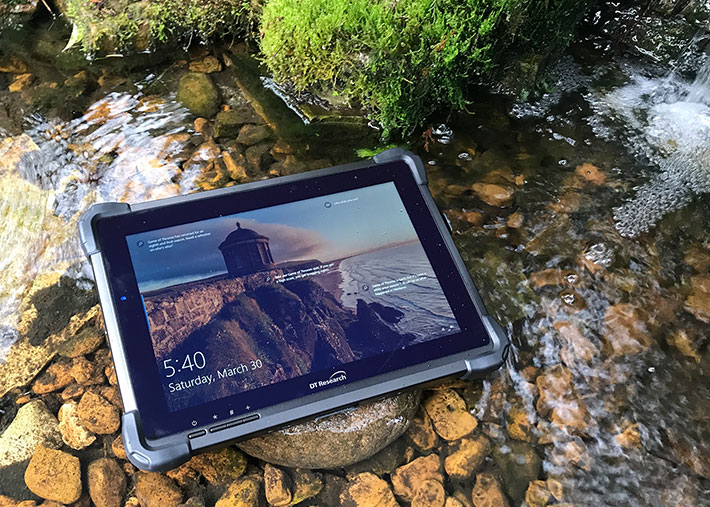
DT Research has kept the platfrom nicely updated, first adding a value-oriented version with an Intel Celeron processor (the DT301C) and a state-of-the-art performance version with Intel 8th generation Core processors (the DT301T). The subject of this review, the DT301X, is based on Intel's latest mobile quad-core chips as well, but also adds a sunlight-readable high-bright display and an optional Intel RealSense 3D camera for emerging augmented reality applications in industry and business.
DT Research was also among the first to make available 2-in-1 hybrid configuration of its compact tablet platforms, featuring water-resistant detachable keyboards, internal hot-swappable batteries, and advanced hardware-software security. Being well aware of current (consumer) market expectations of what a tablet should look like, it doesn't surprise that the DT301 platform skillfully combines elements of traditional rugged tablet design with those of contemporary premium consumer tablets.
A contemporary tablet solution for work and business
Let's start this examination with a look at what the DT301S tablet looks like from the front and from all four sides. This gives an idea of what's similar to an iPad or a Samsung tablet, and where the design differs to provide the ruggedness and functionality required by a serious tool for jobs in the field and any place where substantial computing power is needed away from the office and the safety of a desk or briefcase.

Note how for a rugged tablet the DT301X is a comparatively slender design. It's actually even more slender than what the above side pictures suggest; we're showing them with the heavy-duty rubber hand strap that includes four feet for secure placement on non-flat surfaces, and also with the optional 91 watt-hour extended battery installed. Further, the left and right side-views are shown with their protective port covers open.
DT Research succeeded in creating a device that merges elegant, modern tablet looks with a brawny, functional appearance. The protective bumpers are nicely integrated into the design and, unlike bumpers that are part of the housing, they are easy to replace. Physical controls are kept at a minimum. There are just four small buttons integrated into the design on the left lower part of the tablet. The power/sleep control is slightly recessed so that it isn't activated by mistake.
A trio of programmable buttons labeled *, #, and + are, by default, used to toggle the onscreen keyboard, toggle the Windows menu, and execute the "Security" modern day equivalent of the old alt-ctl-del. A utility allows programming these buttons to whatever the job requires. Anything else is done onscreen.
Rugged tablets usually don't have a lot of onboard connectors because every opening to the vulnerable inside with all of its electronics is another area that needs to be sealed and protected. The DT301X is no exception, but does offer the basics. Those include a single full-size USB 3.0 port, a reversible USB Type-C port, a standard 3.5mm audio jack, and the power jack. There are small white symbol icons underneath the protective door, but not outside. So users must memorize what's where.
What's missing are the usual cooling slots that allow air exchange on many high-powered tablets and laptops. The DT301X doesn't need heat exchanger vents here because it doesn't have a (potentially noisy and troublesome) fan. Removing the heat of the high-performance electronics is done via advanced thermal engineering.
Not just a tablet
Before getting into the performance aspects of the DT301X, we'll touch on how DT Research early on decided to make their tablets more than just tablets. DT Research president Dr. Daw Tsai was quoted as saying "Mobile tablets are fast becoming the 'go to' computing device for the military and other field jobs. But as the use of mobile tablets has risen, we saw that users need the flexibility to use tablets in a variety of settings. Our 2-in-1 ultra-rugged tablets can dynamically adapt to indoor and outdoor use, while remaining light and durable with our signature fully-integrated design."
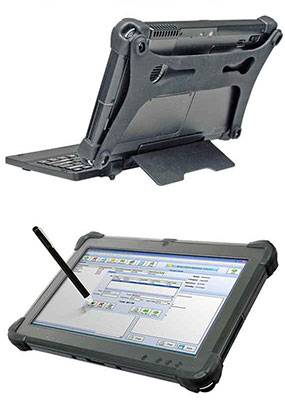 That's important. And it turned out it's also where the tablet market is going. Tablets (and to an even much larger extent smartphones) have revolutionized the world, but it's primarily in the social media and entertainment area. For most work, sitting down with a keyboard is still needed, and may always be needed. That's important. And it turned out it's also where the tablet market is going. Tablets (and to an even much larger extent smartphones) have revolutionized the world, but it's primarily in the social media and entertainment area. For most work, sitting down with a keyboard is still needed, and may always be needed.
While it's possible to connect a keyboard wirelessly or via cable to most tablets, the implementation has to be just right in order for it to truly work. DT Research gave that much thought and created a "2-in-1" solution that works better than most.
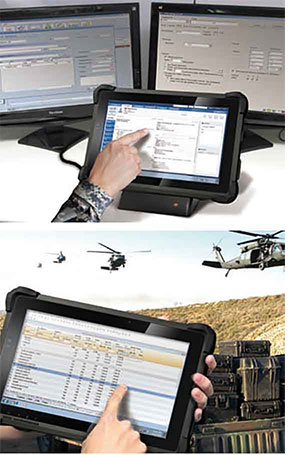 We should state here that 2-in-1s aren't new. They go back pretty much to the beginnings of pen computing and tablets in the early 1990s. But none of those early efforts worked well enough to catch on and become popular beyond certain niche markets. We should state here that 2-in-1s aren't new. They go back pretty much to the beginnings of pen computing and tablets in the early 1990s. But none of those early efforts worked well enough to catch on and become popular beyond certain niche markets.
Initially the problem was that packaging a full computer into a lightweight tablet just wasn't possible. So the attempted 2-in-1s were clumsy and top-heavy.
In 2001, Microsoft promoted the Tablet PC concept, initially as pure tablets, but then as convertible notebooks. Those worked as laptops, but you could also flip the display around and make then into (rather thick and heavy) tablets.
Such convertible notebooks with rotating displays had some success, but not on a larger scale. Most recently, cardboard-thin keyboards that attach magnetically to modern consumer and business tablets have made inroads, but generally don't make for truly practical solutions, and certainly not for industrial tablets.
Learning from the above history of failed or only marginally successful solutions, DT Research came up with the following conclusions:
- the keyboard must be a real keyboard people can actually use, not something that is nearly impossible to type on.
- the keyboard must have real, sturdy hinges for stability and a solid connection.
- the tablet and keyboard must reliably fit and work together.
- the keyboard and all pertaining accessories must be interchangeable within the company's 2-in-1 lineup.
The pictures below show how DT Research ended up implementing the 2-in-1 concept, what it all looks like, and how it can be used.
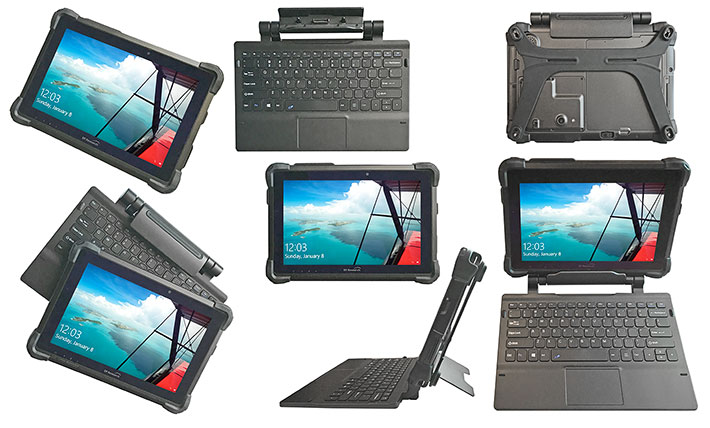
The detachable metal keyboard has 81 keys with the general look and feel of the slender Apple keyboard that has pretty much replaced the large, clunky keyboards of yesteryear. There's a 3-1/4 x 2 inch capacitive touchpad with multi-touch capability. The standard 12 function keys also provide dedicated Windows 10 services such as Cortana, share, connect, and settings.
The keyboard hinge is of heavy construction and very sturdy. Keyboard and tablet communicate via the standard dock connector, staying clear of Bluetooth links that may or may not work. The keyboard has a flip-out stand that keeps the assembly stable when using the combo as a notebook computer. The design of the stand, however, is such that the angle of the tablet is fixed.
Design and construction
As for the DT301 tablet series itself, it is one of the company's newest platforms. Its modern, attractive design makes it instantly clear that this is a rugged, businesslike piece of hardware. The DT301 platform is also flexible enough for DT Research to offer versions with different types of Intel processors, providing various levels of performance in the same fanless package.
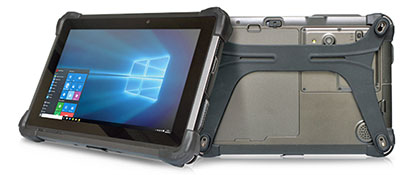 Measuring about 11 x 7.8 x 0.86 inches and weighing around three pounds, the DT301X version has a hot-swappable 61.6 watt-hour battery, and comes with speedy dual-band 802.11ac WiFi and Bluetooth 4.0. Optionally available are a 4G LTE/AWS mobile broadband module, a standard or Intel RealSense 3D rear camera, a 1D/2D barcode scanner, and long distance BlueTooth. Since some DT301 tablet options (like the scanner) replace part of the onboard wired connectivity, DT Research offers an optional desktop dock that adds dual DisplayPort outputs that support 4K UHD resolution, four USB ports, and RJ45 LAN. Measuring about 11 x 7.8 x 0.86 inches and weighing around three pounds, the DT301X version has a hot-swappable 61.6 watt-hour battery, and comes with speedy dual-band 802.11ac WiFi and Bluetooth 4.0. Optionally available are a 4G LTE/AWS mobile broadband module, a standard or Intel RealSense 3D rear camera, a 1D/2D barcode scanner, and long distance BlueTooth. Since some DT301 tablet options (like the scanner) replace part of the onboard wired connectivity, DT Research offers an optional desktop dock that adds dual DisplayPort outputs that support 4K UHD resolution, four USB ports, and RJ45 LAN.
Anyone who doesn't need the extra screen space of a "pro" size tablet, such as DT Research's own 11.6-inch DT311H or 14-inch DT340T, will feel instantly at home with the 10-inch class DT301X. Its footprint is reminiscent of the ubiquitous original iPad, and it offers the same full-HD 1920 x 1200 pixel resolution as the larger DT311H. Like most modern Windows tablets, the DT301X has capacitive multi-touch, and DT Research also offers an active digitizer with a high-precision digital pen.
No RuggedPCReview examination of a rugged device would be complete without taking it appart. In our experience, products from established, reputable manufacturers of rugged mobile computing gear have nothing to fear from a detailed interior inspection. These devices are designed from the ground up to be rugged, and we seldom come across unpleasant surprises. But sometimes we do notice something that catches our attention and we may discuss the matter with the manufacturer.
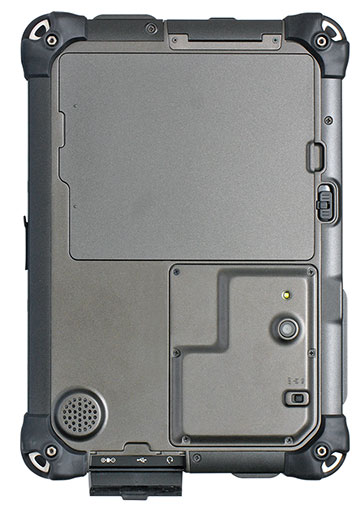 The picture to the right shows the backside of a DT301 platform tablet (shown here the DT301S), with its rubber hand strap removed. The picture to the right shows the backside of a DT301 platform tablet (shown here the DT301S), with its rubber hand strap removed.
Taking a DT301 tablet apart isn't totally trivial. First you undo six small Philips screws to remove an access cover to an expansion slot compartment. It's not just a cover, though, as it also houses the rear documentation camera, a radio on/off switch, a small battery, and it also serves as a heat dissipation sink for the tablet's solid state disk. All of this requires three cables that must be disconnected from the motherboard underneath before proceeding further.
The battery is custom-designed for the DT301 and is part of the tablet, i.e. there is no cover over it. The battery compartment itself isn't sealed, but the connector between the battery and the insides of the tablet is, and that's all that matters. The battery is securely held in place with a combination friction lever/lock.
As far as power goes, the DT301 battery uses Lithium-Ion technology and is rated 11.4Volts and 5,400mAH, which makes for beefy 61.6 watt-hours. The advantage of this type of battery design is that it's easy to offer optional higher capacity batteries, like the 91.2 watt-hour high capacity battery DT Research offers for the DT301T and DT301X.
Next it's time to remove the plastic antenna covers, the protective I/O covers, and the corner rubber bumpers. That's not inherently difficult, but requires undoing a variety of different screws and bolts. Once that is done, the two halves of the DT301 come apart fairly easily. Some caution is required though as there are three cables (power, CAC reader in some DT301 versions, and speaker) that must be disconnected before the two halves fully separate.
The overall construction of the DT301 now reveals itself. Except for the front bezel overlay, pretty much the entire tablet is solid magnesium. Solid as in beefy and heavily reinforced, not the fragile lightweight kind sometimes found in premium consumer tablets. Below you can see the two structural halves of a DT301S, top on the left and bottom on the right.
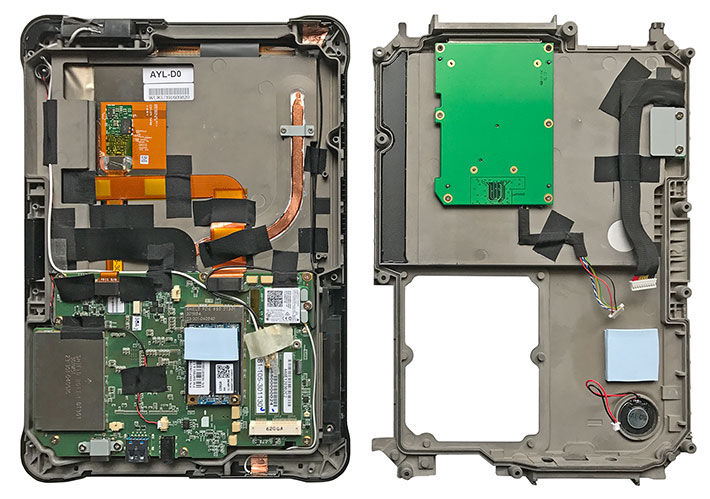
The ever important sealing between the two magnesium halves is via a complex 3D tongue-and-groove design that goes around the perimeter. In the groove sits a replaceable rubber seal.
All major components are mounted on the two sides of the magnesium front half of the tablet, display on one side and electronics on the other. The motherboard measures about 6.5 x 4 inches. It's clearly a custom design for this particular tablet, cut and contoured to fit precisely into its space inside the magnesium frame.
What immediately catches the eye is a curved length of copper heat tubing embedded in the magnesium frame. That's there because of the DT301's fanless design. That's right: no fan despite the powerful Intel dual-core and quad-core processor DT Research offers in the performance versions of the platform. While these chips have a TDP (Thermal Design Power) of just 15 watts, that's still quite a bit of heat to dissipate, and being able to do that without a fan is remarkable.
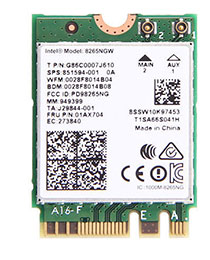 Of components and modules, we see an Intel Dual Band Wireless-AC 8265 2x2 WiFi and Bluetooth 4.2 module. For WiFi, it's about three times faster than 802.11n, up to 867 Mbps with its two antennas both at the transmit and the receive end. Of components and modules, we see an Intel Dual Band Wireless-AC 8265 2x2 WiFi and Bluetooth 4.2 module. For WiFi, it's about three times faster than 802.11n, up to 867 Mbps with its two antennas both at the transmit and the receive end.
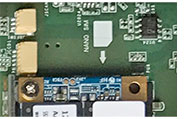 Mass storage in the DT301S we tested a while ago was provided by a 128GB mSATA solid state disk module, sitting on top of a tiny nano-SIM slot (see picture to the left). The latest DT301X version in our lab came with a faster 512GB PCIe NVMe SSD module. Mass storage in the DT301S we tested a while ago was provided by a 128GB mSATA solid state disk module, sitting on top of a tiny nano-SIM slot (see picture to the left). The latest DT301X version in our lab came with a faster 512GB PCIe NVMe SSD module.
A full-size mini-PCIe slot is available for a mobile broadband module or whatever other connectivity may be required. Whatever I/O there is — USB 3.0, USB Type-C, an audio jack, and power — is edge-mounted on the motherboard.
There are a few visible wires, all leading to the various antennae that are located outside of the sealed metallic inner sanctum of the tablet. That's because antennae can't work inside a full metal enclosure. As is usually the case, parts of the motherboard and other electronics are underneath metal shielding. What's impressive is that each of those shields is individually engraved with its number, purpose and that it's for the DT301.
The overall layout is logical and well done. This is certainly no generic design. Everything is custom and as complex and refined as it needs to be to get the job done. Sealing a device of this complexity isn't easy, not with four different radio antenna that all must be outside the actual interior enclosure. To still reach IP65 ingress protection is quite an achievement.
Packing Intel 8th Generation "Kaby Lake R" processor punch
When it comes to a tablet's processor, newer and faster is always better, and having a late model chip under the hood is a competitive advantage. That said, Intel has been struggling the last few years to keep up with its self-imposed pace of progress. It's become increasingly difficult to make everything smaller yet, with process technology, generally defined as "half the distance between identical features in an array," now approaching the single digit nanometer range. So with their 6th, 7th and 8th generation of Core processors, Intel has mostly been optimizing and fine-tuning things.
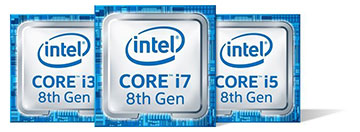 That rapid-fire succession of processor generations makes being "current" with Intel chips a fleeting proposition, and at times even a questionable one. For example, even years after the introduction of Windows 10, an amazingly large percentage of users still prefer Windows 7. As a result, vendors often shipped new products with Windows 10, but also offered a "Windows 7 downgrade" option. That practice was forcibly stopped when Microsoft refused to support Windows 7 on processors newer than Intel's 6th generation "Skylake." That rapid-fire succession of processor generations makes being "current" with Intel chips a fleeting proposition, and at times even a questionable one. For example, even years after the introduction of Windows 10, an amazingly large percentage of users still prefer Windows 7. As a result, vendors often shipped new products with Windows 10, but also offered a "Windows 7 downgrade" option. That practice was forcibly stopped when Microsoft refused to support Windows 7 on processors newer than Intel's 6th generation "Skylake."
Several manufacturers kept offering even their latest products with an older Skylake processor option. That is now coming to an end. That's because there is one major advance in Intel's 8th generation ultra-low voltage mobile Core processors: they are for the first time available in quad-core configuration. Four cores, eight threads. That's accompanied by a fairly substantial reduction of base clock speed and an increase in maximum turbo speed. The idea here is relaxed idling along while doing routine jobs, conserving power. If high loads come along, all four cores kick in at turbo speeds, for maximum performance.
To provide an idea of where the DT301X with its Intel 8th generation "Kaby Lake R" Core i7 chip stands in terms of performance, we ran it through both our old PassMark 6.1 as well as the latest PassMark 9 benchmark suite. For comparison we're also listing the results of the DT Research DT311S with its 6th gen Skylake chip, and some of the competition's high-performance tablets: Dell's Latitude Tablet Rugged Extreme, Durabook's U11, MobileDemand's xTablet T1270, Panasonic's Toughbook CF33, and Zebra's Xplore xSlate L10. Here are the results:
|
DT Research DT301X Benchmarks and Comparisons
|
|
PERFORMANCE COMPARISON
|
DT Research
|
DT Research
|
Dell
|
Durabook
|
MobileDemand
|
Panasonic
|
Zebra
|
|
Model
|
DT301X
|
DT301S
|
Tablet Extreme
|
U11
|
T1270
|
CF33
|
xSlate L10
|
|
Year Tested
|
2019
|
2016
|
2017
|
2018
|
2018
|
2018
|
2018
|
|
Processor Type
|
Intel Core
|
Intel Core
|
Intel Core
|
Intel Core
|
Intel Core
|
Intel Core
|
Intel Core
|
|
Processor Type: Intel
|
i7-8550U (G8)
|
i7-6500U (G6)
|
i7-7300U (G7)
|
i7-7Y75 (G7)
|
i7-7500U (G7)
|
i5-7300U (G7)
|
i7-8650U (G8)
|
|
Code name
|
Kaby Lake R
|
Skylake
|
Kaby Lake
|
Kaby Lake
|
Kaby Lake
|
Kaby Lake
|
Kaby Lake R
|
|
Thermal Design Power (TDP)
|
15 watts
|
15 watts
|
15 watts
|
4.5 watts
|
15 watts
|
15 watts
|
15 watts
|
|
CPU Clock
|
1.80GHz
|
2.50GHz
|
2.60GHz
|
1.30GHz
|
2.70GHz
|
2.60GHz
|
1.90GHz
|
|
CPU Turbo
|
4.00GHz
|
3.10GHz
|
3.50GHz
|
3.60GHz
|
3.50GHz
|
3.50GHz
|
4.20GHz
|
|
CPU Cores/Threads
|
4/8
|
2/4
|
2/4
|
2/4
|
2/4
|
2/4
|
4/8
|
|
Intel Graphics
|
UHD 620
|
HD 520
|
HD 520
|
HD 615
|
HD 620
|
HD 620
|
UHD 620
|
|
CPU Mark 6.1
|
8,182.9
|
4,277.1
|
5,245.9
|
3,775.3
|
5,352.7
|
NA
|
10,289.7
|
|
2D Graphics Mark 6.1
|
419.3
|
473.4
|
454.7
|
280.1
|
496.9
|
NA
|
423.2
|
|
Memory Mark 6.1
|
1,948.5
|
1,338.3
|
1,628.1
|
1,720.6
|
2,286.8
|
NA
|
2,613.7
|
|
Disk Mark 6.1
|
17,808.6
|
3,740.1
|
5,980.5
|
3,997.0
|
15,429.7
|
NA
|
12,791.2
|
|
3D Graphics Mark 6.1
|
440.3
|
468.9
|
496.5
|
367.0
|
686.7
|
NA
|
805.9
|
|
PassMark 6.1
|
6,233.4
|
2,266.2
|
3,028.8
|
2,211.7
|
5,094.8
|
NA
|
5,962.9
|
|
CPU Mark 9.0
|
8,658.0
|
NA
|
5,394.0
|
3,615.6
|
5,606.4
|
5,424.2
|
8,848.7
|
|
2D Graphics Mark 9.0
|
625.9
|
NA
|
669.9
|
447.8
|
753.6
|
600.1
|
664.1
|
|
Memory Mark 9.0
|
2,379.6
|
NA
|
2,219.9
|
2,109.1
|
2,785.0
|
2,277.6
|
2,297.6
|
|
Disk Mark 9.0
|
23,816.7
|
NA
|
7,611.8
|
3,826.2
|
14,498.1
|
3,142.9
|
11,050.9
|
|
3D Graphics Mark 9.0
|
1,200.2
|
NA
|
1,133.9
|
691.5
|
1,264.3
|
473.2
|
1,219.4
|
|
PassMark 9.0
|
3,601.9
|
NA
|
3,083.7
|
2,084.1
|
3,506.0
|
2,205.9
|
3,609.1
|
The tablets listed above are all premium high-performance industrial products that pack a considerable punch. There is generally remarkable performance parity among the highest performance versions of each product line in that class, and so bottomline benchmark numbers (PassMark numbers, anyway) usually come down to processor generation and how quick the storage subsystem is.
Perusing the results, it seems that the PassMark benchmarks are struggling providing consistent results between versions 6.1 and 9. Whereas PassMark 6.1's weighting favored high storage performance and the number of cores, PassMark 9 dialed the impact of storage performance way down. We have to assume that experienced benchmark designers know what they're doing and that they are allowing sufficiently for new and at times disruptive technologies. However, in this era of migration from dual to quad Core setups in the CPU area, and SATA to PCIe NVMe in mass storage, caution is advised with benchmarking numbers.
Even taking all that into consideration, the DT Research DT301X put in a spectacular performance, clocking the highest PassMark 6.1 score we've ever seen in our lab, and it also scored among the very top in the PassMark 9 tests, practically tying our all-time tablet performance champ (the Zebra Xplore L10).
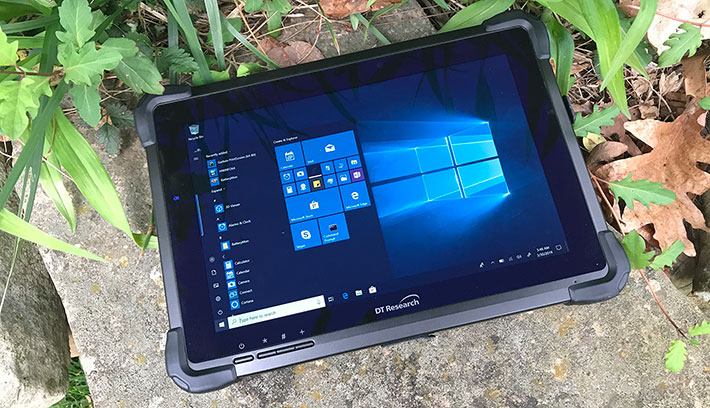
Very low power consumption (with the right settings)
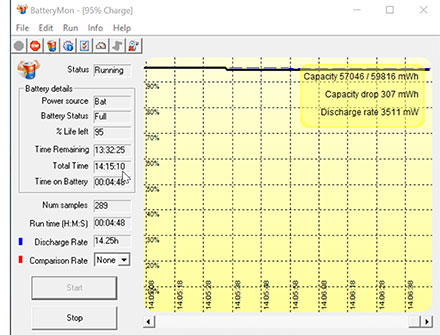 Back in the day, high performance in a mobile computer meant short battery life. Technological advances have changed for the better, but how long could the very fast DT301X with its very bright display possibly last on a single charge of its battery? Back in the day, high performance in a mobile computer meant short battery life. Technological advances have changed for the better, but how long could the very fast DT301X with its very bright display possibly last on a single charge of its battery?
To find out we used Passmark Software's BatteryMon power management benchmark utility to measure the DT Research tablet's power draw under various operating conditions.
First we set the power options to "Best Battery Life" on the Windows 10 Power Mode slider, and set display brightness to its lowest setting (0%). That way we saw a very low idle power draw of just 3.5 watts.
We then cranked the backlight up to 50%, and draw increased to 5.1 watts. Then we cranked brightness all the way up to 100% and saw 6.5 watts. That's with the tablet being awake, just idling along.
Next we set the Windows 10 power options to "Best Performance" on the Windows 10 slider and display brightness back to its lowest setting (0%). That way we saw an idle power draw of 3.8 watts. We then cranked the backlight up to 50% and draw increased to 5.8 watts. Then we cranked brightness all the way up to 100% and saw 8.1 watts.
|
DT Research DT301X Power Draws (at idle)
|
|
Backlight level
|
Lowest (0%)
|
50%
|
Maximum (100%)
|
|
Power Saver
|
3.5 watts (17.6 hrs)
|
5.1 watts (12.1 hrs)
|
6.5 watts (9.5 hrs)
|
|
Max Performance
|
3.8 watts (16.2 hrs)
|
5.8 watts (10.6 hrs)
|
8.1 watts (7.6 hrs)
|
The table on the right summarizes those results, and also shows how the recorded power draws translate into battery life on the DT301X's standard 61.6 watt-hour battery. Theoretical running times (idling, no sleep) are as high as a stellar 16.6 hours, and even at full brightness and "max performance" setting, the standard battery would yield 8.1 hours. If that's not enough, the optional 91.2 watt-hour battery provides almost 50% more capacity.
These figures are much better than what we measured on the Intel "Skylake" Core i7-6500U powered DT301S a couple of years ago. How can that be possible?
There are a number of reasons. First, while the new Kaby Lake R quad-core processor in the DT301X is a powerhouse, its default clock speed is just 1.8GHz, much lower than the 2.50GHz of the dual-core Skylake chip in the DT301S we tested. Second, Intel's power management is getting better and better. And third, Windows 10's own power management and settings are becoming more sophisticated as well. For example, different power modes can have different maximum display brightness, leading to longer battery life. What all of this means is that a modern high-performance tablet like the DT Research DT301X is much like a modern high-performance car: advanced tuning allows both great power and efficient idling through town. Settings, both by the factory and by the user, are becoming ever more important.
Bright, excellent 10.1-inch full HD display
The DT301X tablet's 10.1-inch display offers full HD 1920 x 1200 pixel resolution, making for 16:10 aspect ratio and a sharp 224 pixels per inch. That's about the same pixel density as Apple's retina iMacs and MacBooks. The display surface is of the glossy variety seen today on virtually all tablets and smartphones.
Indoors, the DT301X display is very pleasant to use and work on, and full brightness is never needed. Outside viewability depends on lighting conditions, reflections, contrasts, viewing angles and more.
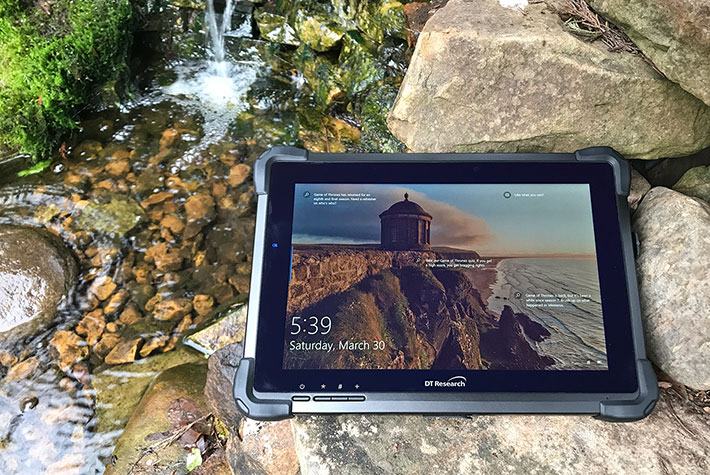
Not too long ago, outdoor viewability was the weak point of most rugged mobile computing devices. Display technologies — reflective, transflective, hybrids and others — came and went, none yielding truly acceptable results. Eventually the industry decided that modifying conventional transmissive LCDs for daylight and sunlight use was the best currently available way to go.
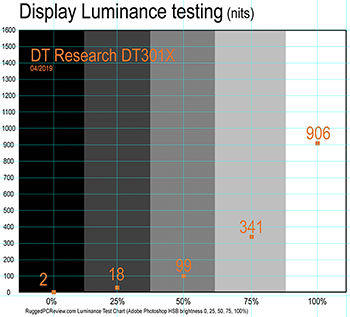 That's done by reducing the display's internal reflection of ambient light so that, in conjunction with a reasonably strong backlight, there is enough contrast to make the screen viewable outdoors. This reduction of internal reflection is accomplished via a combination of polarizers, filters, coatings and elimination of air spaces between the various layers of the LCD.
That's done by reducing the display's internal reflection of ambient light so that, in conjunction with a reasonably strong backlight, there is enough contrast to make the screen viewable outdoors. This reduction of internal reflection is accomplished via a combination of polarizers, filters, coatings and elimination of air spaces between the various layers of the LCD.
Almost all mobile devices use this technology today, but the exact implementation varies from manufacturer to manufacturer. As does the strength of the backlight (a stronger backlight means a larger battery or shorter battery life).
Backlight strength varies with the type of device. Desktop monitors and standard notebooks are usually in the 200 nits range. Modern smartphones and tablets are between 400 and 600 nits. Rugged laptops are available with as much as 1,500 nits. Cranking luminance up too high can make for a washed-out look and quickly drains batteries. So DT Research settled on 800 nits for the DT301X.
The graph to the right shows how the tablet did in our luminance test. At full black we measured just under 2 nits, at full white we saw as high as 906 nits, more than the 800 nits in the specs. That's likely because luminance varies depending on the location of the backlight.
The picture below shows the DT301X outdoors on a bright, sunny day with the backlight cranked all the way up to 100%. On the left is what it looks in the shade, on the right when it's in full sunlight. Unlike older tablets and many consumer notebooks where the picture pretty much disappears in sunlight, the DT301X remains viewable, and viewable means usable for work.
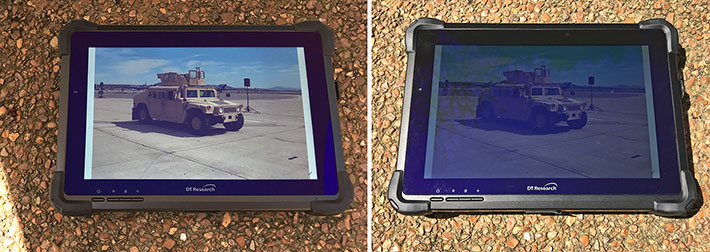
The next picture shows the DT301X sitting next to an Apple iPad Air 2, outdoors in the shade, with backlight at maximum. The DT301X's 800 nits is clearly brighter than the iPad's 420 or so nits. Both displays are glossy, and neither is immune to reflections. That means you'll be often repositioning the tablet to minimize reflections.
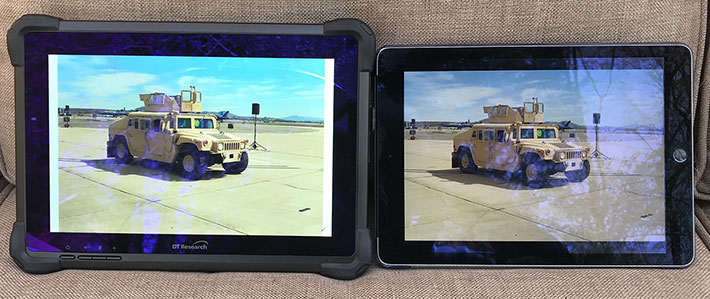
Overall, the display of the DT301X is about as good as it gets with current display technology. It's bright enough, it has near perfect viewing angles, there are no contrast and color shifts when viewing even from extreme angles, and reflection control is as good as it currently gets.
Optional cameras
As is usually the case these days with tablets, smartphones and notebooks, the DT301X has integrated imaging capabilities via two camera options. Unlike other members of the platform, the DT301X does not have a front camera, not even as an option. The advantage of that is that there's no camera that can inadvertently spy on the user. The disadvantage is that you can't do video calls.
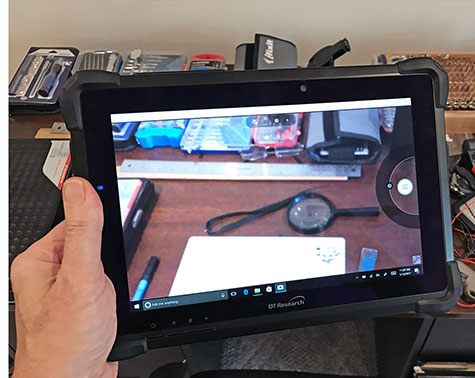 There are, however, rear camera options. One is a standard 8-megapixel camera with auto focus, white balance, gain control, and exposure control. There are, however, rear camera options. One is a standard 8-megapixel camera with auto focus, white balance, gain control, and exposure control.
The other is an Intel RealSense Depth back camera that supports distance capture for 3D scanning, environment sensing, and background segmentation applications. This is an emerging technology whose application potential is limited only by imagination. As an example, DT Research lists real-time 3D imaging that can create very accurate measurements for use by crime scene forensics teams. The camera can record scientific-grade data as court evidence for investigators or legal teams. Microsoft Windows 10 IoT Enterprise operating systems allow flexible integration for the RealSense Depth camera.
Our review unit came with the regular 8-megapixel camera and uses the Windows Camera app that defaults to 1920 x 1080 pixel, despite the camera's much larger imager. You can, however, switch to 3264 × 2448 pixel format that uses the entire 8 megapixel.
Video, likewise, defaults to 1920 x 1080 at 30 frames per second but here, too, you can switch to (unusual) 2448p video in 4:3 format, which means the same 3264 × 2448 pixels as the highest still resolution. That's actually close to the same pixel count as 4k video (3840 x 2160), only in a 4:3 aspect ratio instead of the common 16:9 wide format.
In still photography, auto-focus was a bit of a mystery, sometimes focusing as it should, other times seeming uncertain. Most PC cameras allow tapping on the subject you want to focus on, but that feature isn't available here. Most, but not all, test images were reasonably to very sharp, the camera did not over-compress images, and operation was quick. The same applied to video. What's missing is frame rates higher than 30 fps. Those come in handy for slow-motion.
What has always been a mystery to us is why the standard, official Windows 10 Camera app does not provide access to a computer's full camera hardware capabilities. Controls for still pics were limited to time delay (2/5/10 seconds), time lapse shooting, aspect ratio (16:9 or 4:3), and exposure compensation.
The pictures below were taken with the DT301X's camera in its highest 4:3 aspect ratio 3264 × 2448 pixel resolution (click on the sample pics for a full-size version of the entire picture compilation).

With almost everyone carrying a smartphone in their purse or pocket, integrated cameras are no longer as important as they once were. The 8mp camera in the DT301X has the potential to be very useful, but it may need some tweaking (or the company's own DTSMCap camera app?). The Intel RealSense Depth camera option, however, is a different and more interesting animal. That has significant potential.
Docks, accessories, and peripherals
Since the DT301 tablet platform doesn't offer the onboard wired connectivity of a rugged laptop, DT Research offers a handy, compact optional desktop dock that adds dual DisplayPort outputs that support 4K UHD resolution, four USB ports, and RJ45 LAN.
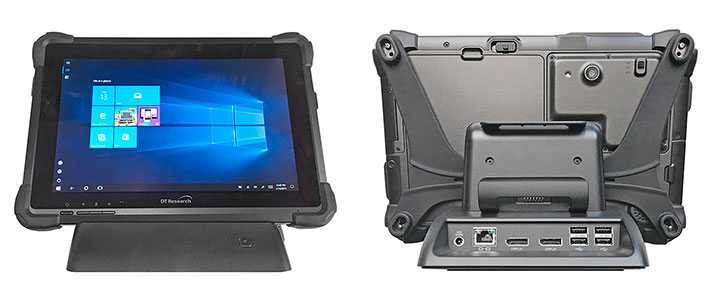
Other accessories include a DisplayPort-to-DVI adapter that also enables running dual external displays off the dock; a wall/vehicle cradle with LAN pass-through and two USB ports that accepts power through a cylindrical 19V plug or a 12V-24V pluggable Phoenix terminal block connector. We've covered the 2-in-1 keyboard earlier in this review, and DT Research also offers a separate keyboard tray with a USB keyboard for use with the wall/vehicle cradle.
Elegant tablet that can take a beating
Hundreds of millions are using tablets now, but most of those are too fragile for field or even enterprise use. That's why there are rugged tablets like the DT301X. Problem is that making a tablet rugged increases cost, size and weight. So designers and manufacturers of such heavy duty tablets must find just the right balance for their products: Tough enough for the job, attractive enough to appeal, but still affordable and handy enough for effortless use.
Thanks to its ABS+PC polycarbonate and magnesium-aluminum alloy construction, the DT301X is a lot sturdier and tougher than its light and elegant design suggests.
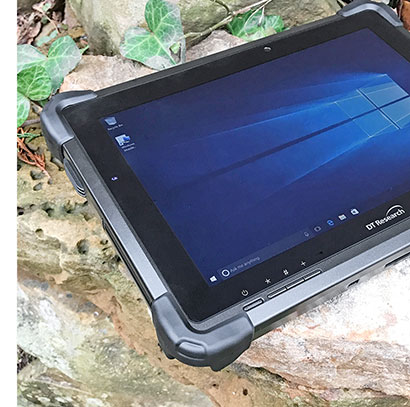 The specs state IP65 sealing, which means the device is fully protected against dust, and also protected against low pressure water jets from all directions, albeit with, according to the IP spec, "limited ingress permitted." The specs state IP65 sealing, which means the device is fully protected against dust, and also protected against low pressure water jets from all directions, albeit with, according to the IP spec, "limited ingress permitted."
IP65 is pretty much the expected norm for tablets in this class. In essence, IP65 here means you can use it in the rain, it won't mind sitting in a puddle or being washed off, but dropping it into a stream isn't a good idea. And do make sure the protective doors are closed when using the tablet in wet conditions.
The standard operating temperature range is a very wide -4 to 140 degrees, making the system deployable almost anywhere, including in commercial freezers.
DT Research also claims MIL-STD-810G testing for drop, shock and vibration, as well as MIL-STD-461F certification for EMI and EMC tolerance. Here it would be good to see more detailed information in the spec sheet and promotional materials. Customers are interested in rugged tablets because they can handle more abuse, so specific information on just how much abuse should be included.
Subjectively, despite its elegant, contemporary design, the DT301X does look as tough and rugged as it actually is. As our internal inspection of the DT301 platform revealed, with its heavy-duty magnesium frame inside and the hefty rubber corner guards outside, it can handle a good deal of punishment. The tablet feels solid and trust-inspiring, too, without any flex or creaking. That said, it would be good to know what sort of strengthened glass DT Research used and also what sort of scratch resistance the elegant metallic and plastic surfaces provide.
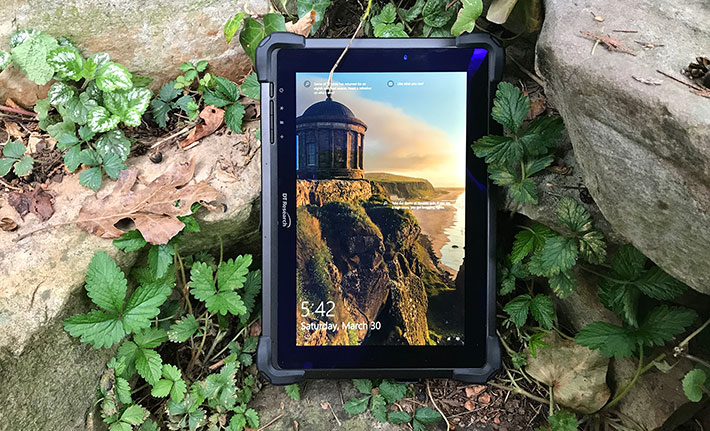
Summary: DT Research DT301X rugged 2-in-1 tablet computer
With the light and compact high-performance DT301X, DT Research offers yet another version of its state-of-the-art thin-and-light tablet that's tough enough to be deployed in a vast array of applications that require more durability and resistance to harsh environmental conditions than consumer tablets can provide, even if they are in a case.
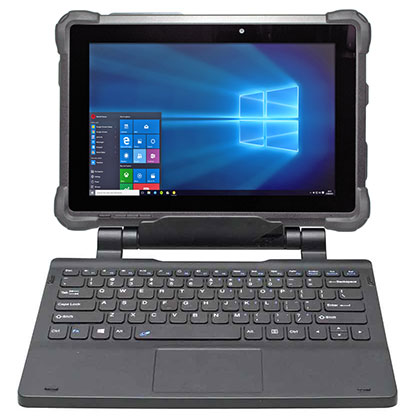 As a tablet, the Intel 8th generation quad-core processor powered DT301X offers a very bright, daylight-viewable 10.1-inch capacitive multi-touch display with full HD resolution, perfect viewing angles from all directions, and an optional active pen with a pencil-thin, pressure-sensitive tip. As a tablet, the Intel 8th generation quad-core processor powered DT301X offers a very bright, daylight-viewable 10.1-inch capacitive multi-touch display with full HD resolution, perfect viewing angles from all directions, and an optional active pen with a pencil-thin, pressure-sensitive tip.
Weighing just under three pounds, the attractively designed magnesium-alloy tablet is tough and well protected.
Equipped with a full-size USB 3.0 port, a reversible USB Type-C port, 3.5mm audio jack, and an RJ45 LAN jack, the DT301X can be custom configured with a standard or an Intel RealSense rear cameras, 1D/2D barcode scanning, long-range Bluetooth, mobile broadband, as well as discrete GNSS.
The optional detachable keyboard converts the DT301X into a hybrid 2-in-1 device that can instantly provide full laptop functionality without the extra bulk and weight of a permanently attached keyboard. The addition of a 2-in-1 version of the DT301X is timely and certainly makes the platform that much more attractive.
An optional desktop dock provides dual DisplayPort outputs capable of 4K UHD resolution, four USB ports, and RJ45 LAN. A wall/vehicle cradle with USB keyboard tray is available as well.
All of this combines into a modern, state-of-the-art Windows 10 2-in-1 tablet hybrid solution with the kind of stellar performance required for even the most demanding field applications. -- Conrad H. Blickenstorfer, April 2019
DT Research DT301X Specs:
| Status |
Added 07/2016, full review DT301S 01/2017, review DT301X 04/2019
|
| Type |
Rugged Mobile 2-in-1 Windows tablet
|
| Processor |
Quad-core Intel "Kaby Lake Refresh" Core i7-8550U or
Quad-core Intel "Kaby Lake Refresh" Core i5-8250U
|
| CPU Speed |
Core i7-8550U: 1.8GHz (max. turbo speed 4.0GHz)
Core i5-8250U: 1.6GHz (max. turbo speed 3.4GHz)
|
| Graphics |
Core i7-8550U: Intel UHD Graphics 620 (300MHz/1.15GHz)
Core i5-8250U: Intel UHD Graphics 620 (300MHz/1.10GHz)
|
| CPU Thermal Design Power |
Both 15 watts |
| OS |
Windows 10 IoT Enterprise
|
| Memory |
8GB or 16GB
|
| Display |
Outdoor-viewable TFT with LED backlight, 800 nits luminance, anti-reflection coating |
| Display Size/Resolution |
10.1-inch/1920 x 1200 pixel FHD (224 ppi) |
| Digitizer |
Capacitive multi-touch, optional active digitizer/pen with replaceable 1.5mm tip (uses AAAA battery) |
| Keyboard |
Optional detachable 81-key keyboard, 3 programmable buttons, RF button |
| Navigation |
Stylus, touch |
| Storage |
128GB to 2TB Flash (test unit had Samsung NVMe MZVLB512 SSD)
|
| Expansion slots |
NA |
| Housing |
ABS+PC bezel; magnesium structure/frame |
| Size |
11.0 x 7.8 x 0.86 inches (280 x 198 x 22 mm) |
| Weight |
3.1 lbs. (1.4kg) |
| Operating temperature |
-4° to 140°F (-20° to 60°C)
|
| Ingress protection |
IP65 |
| Altitude |
unknown
|
| Drop/shock |
MIL-STD-810G (4-foot drop) |
| Vibration |
MIL-STD-810G |
| Regulatory |
FCC Class B, CE, RoHS compliant |
| EMC |
MIL-STD-461F |
| Power |
Hot-swappable 11.4V 5,400 mAH Li-Ion (61.6 watt-hours); optional hot-swappable 11.4V 8,000 mAH Li-Ion (91.2 watt-hours)
|
| Cameras |
Optional: rear-facing 8mp back AF camera with LED flash, optional 3D Intel RealSense camera
|
| Data capture |
Optional: 1D/2D barcode scanner, HF/RFID 13.56MHz reader
|
| Sensors |
Accelerometer
|
| Interface |
1 x USB 3.0, 1 x USB Type-C, 1 x RJ45 LAN, 1 x 3.5mm audio in/out, power
|
| Wireless options |
Intel Dual Band Wireless-AC 8265 802.11ac WiFi, Bluetooth v4.2 (optional Class 1 (1,000 feet) BT available), optional: 4G LTE, HSPA+, GSM/GPRS/EDGE, EV-DO, Rev A and 1xRTT; ublox M8 GNSS module
|
| Price |
Inquire |
| Product page |
DT301X web page |
| Spec sheet |
 DT301X brochure (PDF) DT301X brochure (PDF)
|
| Warranty |
1, 2, or 3 year extended or no-fault options
|
|
Contact
|
DT Research
2000 Concourse Drive
San Jose, CA 95131, USA
Tel: (408) 934-6220
Fax: (408) 934-6222
Web: www.dtresearch.com
|
(copyright 2019 RuggedPCReview.com)
|






